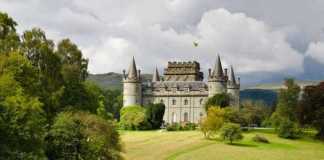Famous for beer, waffles and chocolate, Belgium is a must-visit country for any foodie. There is however much more to Belgium than tasty treats. Belgium is a small country and is densely populated with quaint medieval towns, incredible examples of renaissance architecture and beautiful natural landscapes. Badly scarred by World War 1, many of Belgium’s landmarks are a poignant and respectful of the war through its immaculately preserved war graves, monuments and memorials.
The people of Belgium speak Dutch, French and German, however, English is widely understood and spoken by many. Within Belgium are over 3000 castles, 1000 breweries and countless hidden gems to explore. Here are 20 incredible natural and historical landmarks in Belgium to feed your travel bug.
20 Belgium Landmarks
Natural Landmarks in Belgium
1- The Hallerbos
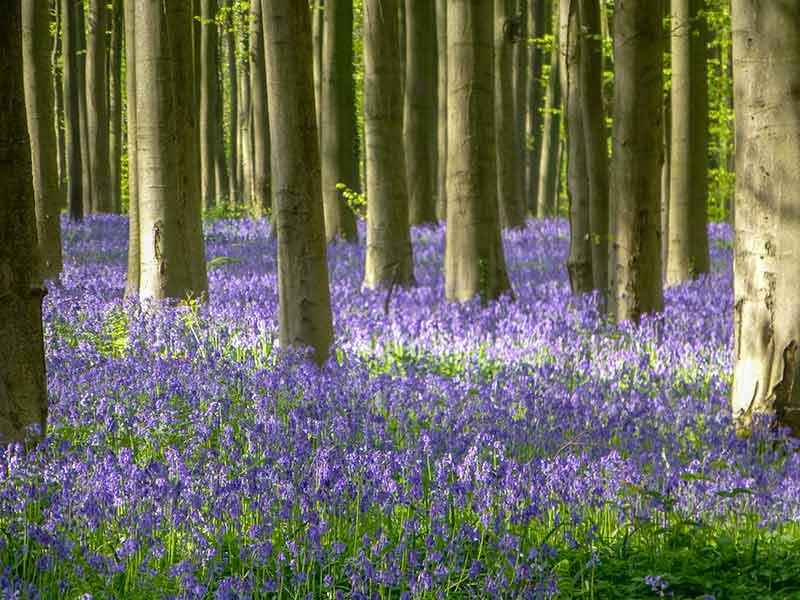
Known locally as ‘The Blue Forest’, the Hallerbos is an extensive forest between Zenne and Zoien.
The forest’s nickname comes from the carpet of bluebells that covers the forest floor in April.
While the current prediction for the blooms is mid-April, they have flowered as late as May and as early as March.
The weather dictates blooms, however, the forest itself is still magnificent even without its blue carpet.
Towering over the delicate purple blooms are giant Sequoia trees and white-barked beech trees, adding to the forest’s magical feeling.
Hallerbos is only 12.4 miles (20 km) from Brussels, Belgium’s capital city, but few travellers make the journey allowing for a peaceful, if carefully timed, visit.
The Hallerbos is at Halle, Flemish Brabant.
2- Grottes de Hotton
Grottes de Hotton was discovered in 1958.
Formed in nearly vertical layers, the caves were tilted by the same forces that created the Ardennes mountain range.
The caves feature unusual stalagmites including mini corkscrews and bizarre horizontal protrusions.
The most prominent feature is the descent down a former siphon, through a vertical strata which opens out into a narrow 37m (121ft) high chasm.
Tours are with an English speaking guide who will lead visitors 65m (213ft) underground to the river, the noise of which echoes around the chasms.
Grottes de Hotton is at 1 Chemin du Speleco Club, 6990 Hotton.
3- Minnewater Lake
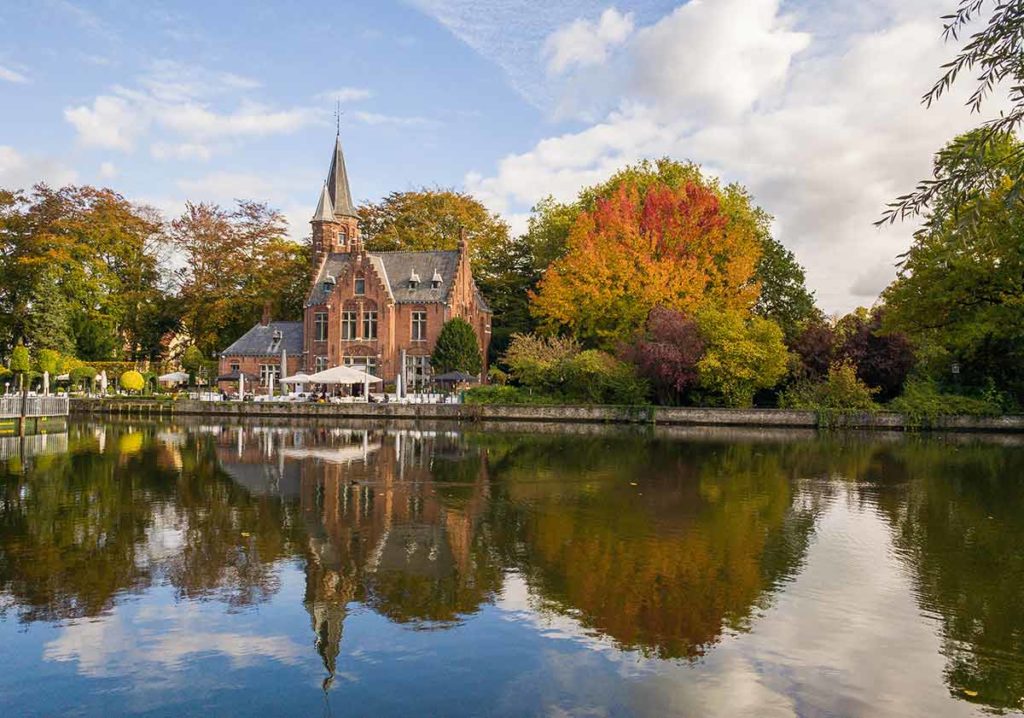
Minnewater Lake, or the ‘Lake of Love’ is in southern Bruges, in Minnewater Park.
According to the story, a young girl fell in love with a warrior from a neighbouring tribe.
As her father disagreed with their love affair, he arranged a marriage with a more suitable man.
Distraught, the girl ran into the forest.
When the warrior found the young girl, she died in his arms of exhaustion. The girl’s name was Minna, giving the lake its name.
A bridge by the lake is known as the bridge of love, in memory of this legend.
The parkland surrounding the lake is calm and tranquil.
On the water are swans, the emblem of Bruges, making for a perfect photographic opportunity.
Minnewater Lake is at Minnewater 1, Brugge.
Discover more Famous World Landmarks:
- 25 Australian Landmarks
- 20 New Zealand Landmarks
- 20 African Landmarks
- 21 Egyptian Landmarks
- 20 Jordan Landmarks
- 10 Tasmanian Landmarks
- 20 Antarctica Landmarks
4- Sonian Forest
Sonian Forest is an ancient forest filled with a diverse variety of trees, flora and fauna.
The beech trees standing in the forest are over 200 years old, and the forest covers more than 5000 ha of oak tree groves, meadows and three fishing lakes.
Comprising of five nature reserves, the forest is an important ecological area for rare biotopes, endangered habitats and animals.
To preserve this natural landmark of Belgium and encourage growth, the forest is managed carefully, with dead or hollow trees maintained to protect the natural ecosystems.
Visit Bosmuseum Jan Van Ruusbroec in the centre of the forest to learn more about forest management and the species that grow within it.
Sonian Forest is at 1150 Woluwe-Saint-Pierre.
5- Rocher Bayard
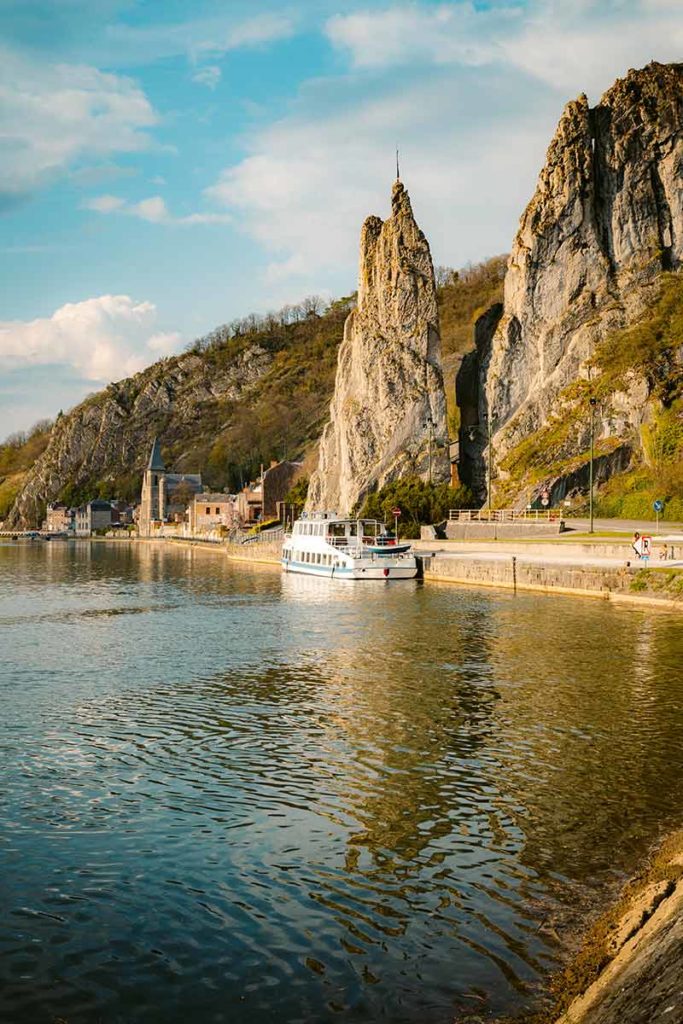
Rocher Bayard is an unusual rock formation in Dinant.
This Belgian landmark is 40m (131ft) high and is split into two halves – one connecting to the craggy cliffs, the other stood alone by the water’s edge.
Legend says that the Bayard horse split the rock in two with its foot as it fled from Charlemagne.
Between the two rock pillars is a narrow path, which has twice been widened.
Rocher Bayard is at 5500 Dinat.
6- Saint Remacle Cave
Saint Remacle Cave was named after Saint Remacle, an apostle from the Ardennes.
The caves are nestled in rocky slopes overhanging the Semois river.
According to legend, Saint Remacle and his donkey lived within the caves, and local villagers gave them gifts.
When Satan learnt this, he transformed into a wolf and attacked the donkey.
Using his rosary, the Saint hung it around the creature’s neck and turned him into a wolf but it took years before Satan could escape his animal prison.
The walk up to the caves is pleasant under the canopy of trees to the small cave that features a statue of the Saint at its entrance.
Saint Remacle Cave is at the forest near the Semis River, Cugnon and Auby-sur-Semois.
7- Les Aiguilles de Chaleux
Les Aiguilles de Chaleux is a stunning limestone rock formation named as a landmark of exceptional heritage of Wallonia.
Les Aiguilles de Chaleux varies in colour from iridescent white to sand to darker greys.
Surrounded by the Lesse River, this Belgian landmark is popular with rock climbers and is associated with extreme sports.
La Chandelle, a part of the rock, is dangerous and closed to climbers.
Les Aiguilles de Chaleux is at Chaleux 1, 5560 Houyet.
8- Reinhardstein Waterfall
Reinhardstein Waterfall is the highest waterfall in Belgium, cascading over 60m (196ft).
The walk to the waterfall is popular with hikers as it takes in incredible views of Reinhardstein Castle.
The cascading waterfall is surrounded by dense woodland and is a picturesque spot for photographs.
The waterfall is little known, and a perfect hidden gem to visit while in Belgium.
Reinhardstein Waterfall is at 4950 Waimes.
For more amazing European Landmarks, read:
- 30 Spain Landmarks
- 20 Switzerland Landmarks
- 22 Germany Landmarks
- 35 London Landmarks
- 30 France Landmarks
- 20 Italy Landmarks
- 20 Greece Landmarks
- 20 Russia Landmarks
- 20 Scotland Landmarks
- 20 Ireland Landmarks
- 21 Wales Landmarks
- 20 Turkey Landmarks
- 20 England Landmarks
- 20 Hungary Landmarks
- 21 Romania Landmarks
- 20 Ukraine Landmarks
- 20 Athens Landmarks
- 20 Rome Landmarks
- 20 England Landmarks
- 20 Portugal Landmarks
- 20 Poland Landmarks
- 20 Iceland Landmarks
- 20 Bulgaria Landmarks
- 21 Croatia Landmarks
- 20 Bulgaria Landmarks
- 20 Austria Landmarks
- 21 Finland Landmarks
- 20 Sweden Landmarks
- 20 Denmark Landmarks
- 20 Belgium Landmarks
- 20 Netherlands Landmarks
- 20 Barcelona Landmarks
- 21 Czech Republic Landmarks
- 20 Landmarks in Paris
- 20 Landmarks in Liverpool
- 10 Istanbul Landmarks
Historical Landmarks in Belgium
9- The Atomium
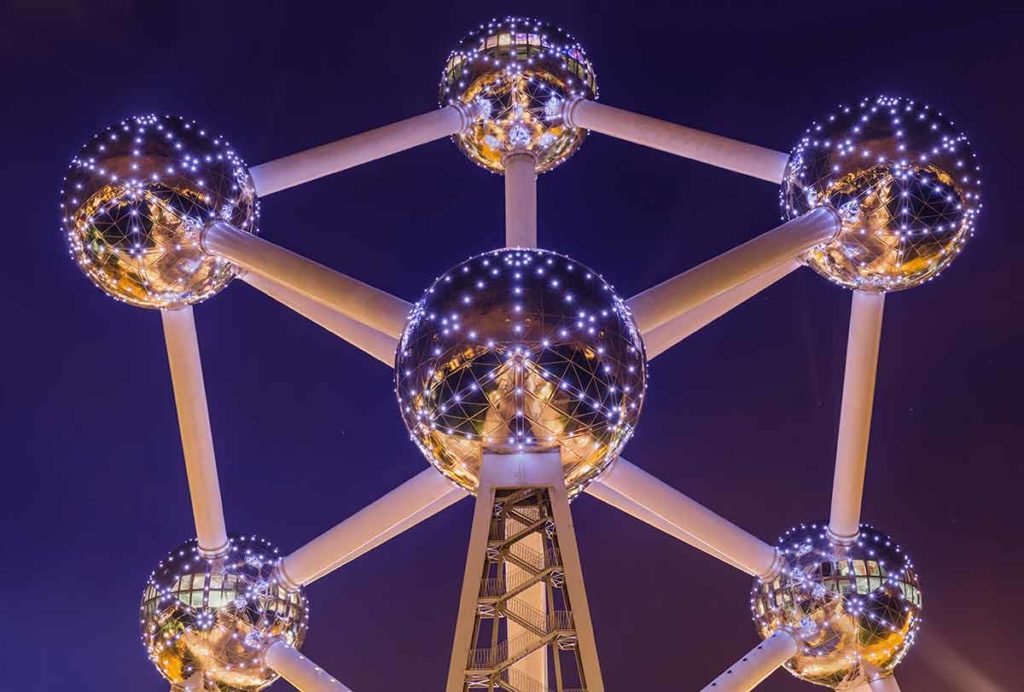
A famous modern landmark in Brussels is The Atomium, a unique sculpture that is the most popular tourist destination in the capital.
The Atomium was created for the first Universal World Exhibition following World War II.
The sculpture consists of nine giant spheres, representing an iron crystal magnified 165 billion times, linking to humanity’s belief in nuclear power.
The Atomium isn’t only a spectacular sight to marvel at, but one you can explore.
Visitors can walk between the tubes and spheres, and see a panoramic view from 92m (300ft) across the city.
There is also a restaurant featuring locally sourced ingredients and a Belgian-focused menu.
The Atomium is at Atomiumsquare 1, 120 Laeken.
10- The Royal Greenhouses of Laeken
The Royal Greenhouses of Laeken is one of Belgium’s more exclusive landmarks.
One curious fact about these greenhouses is that they are only open to the public for three weekends a year, from mid-April to the first week in May.
The greenhouses have been opened at those times for a century, as they are a part of the Royal Park.
As opening times are restricted, there’s always a queue, so arrive early or you may not get in. Unfortunately, tickets can’t be purchased in advance.
The greenhouses are home to King Leopold II’s plant collection, which he added to frequently following his travels.
Visit the Orangery, the oldest structure in the gardens, and the Theatre Greenhouse, the first greenhouse made of steel and glass.
The Royal Greenhouses of Laeken is at Royal Parc de Laeken, 1020 Brussels.
11- Brussels’s Grand-Palace
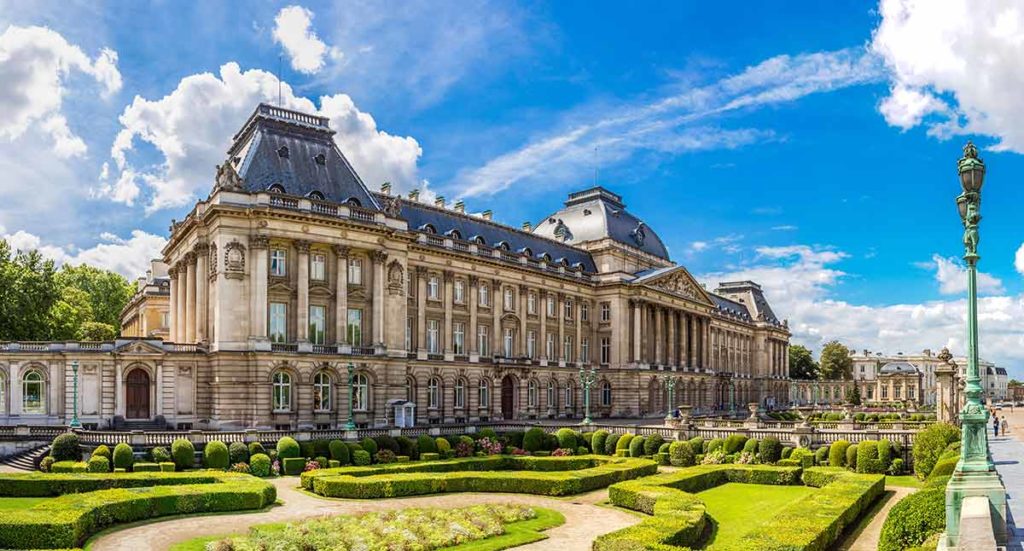
In the central square of Brussels stands the Grand-Palace, a UNESCO World Heritage Site.
The palace is famous for its flower carpet, a giant floral arrangement planted outside the palace, displayed every other year in August.
The flowers are arranged into an intricate pattern and are only on display for one week.
The palace has remained untouched since 1695, allowing its baroque and gothic style to be a significant landmark within the city.
The building is festooned with gold and intricate carvings, topped with a lavishly decorated tower.
The Grand-Palace is at Grote Markt, 1000 Brussels.
12- Horta Museum
Victor Horta, a famous artist from Belgium, built his house and studio in a typical Art Nouveau style between 1898 and 1901.
The Horta Museum is an Art Nouveau museum with from intricately designed door handles to ornately carved wood and twisted metal.
Much of the interior design has been preserved, and visitors to the Horta Museum step back in time as they meander through its rooms.
The museum displays mosaics and stained glass and has a research centre focused on Art Nouveau.
Horta Museum is at 27 rue Americaine, 1069 Brussels (Saint-Gilles).
13- Saint Bavo’s Cathedral
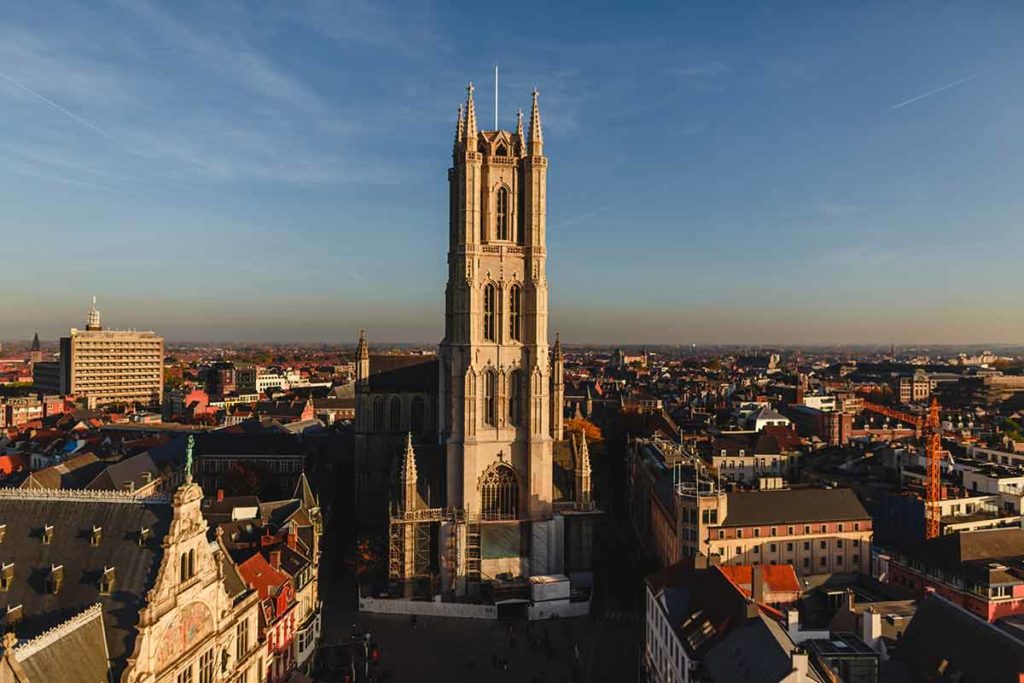
Saint Bavo’s Cathedral is Ghent’s oldest parish church and has a fascinating history.
The cathedral stands on a holy site where a 10th-century church and a 12th-century Romanesque church once stood.
The cathedral was redesigned in the Gothic style in the 1500s and when it was completed in 1559, it became a cathedral.
It has many treasures including a baroque high altar made from white, black and red marble and masterpieces by Rubens.
The most famous artwork in the cathedral, ‘The Adoration of the Mystic Lamb’ by the Van Eyck Brothers, draws thousands of tourists each year.
Saint Bavo’s Cathedral is at Sint-Baafsplein, 9000, Ghent.
14- The Basilica of the Holy Blood
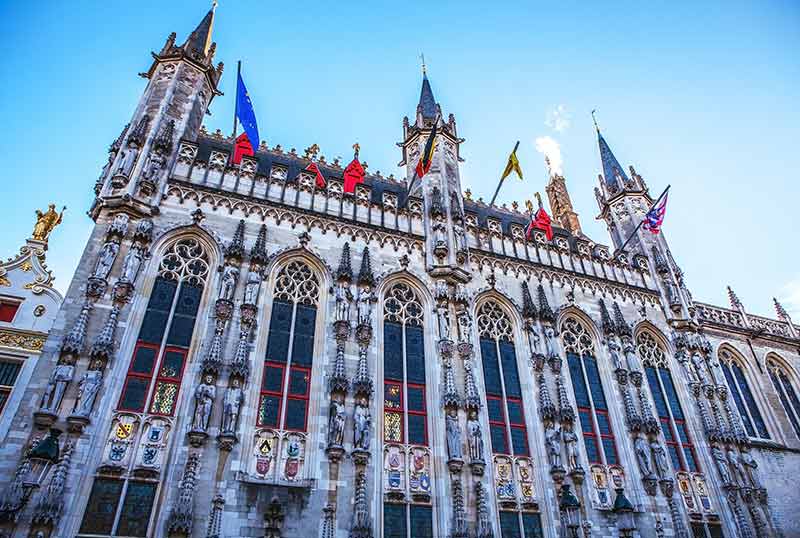
A more unusual and sacred landmark in Belgium is displayed inside the Basilica of the Holy Blood, a 12th-century chapel in Bruges.
Within the church is a vial believed to contain a piece of cloth stained with the blood of Christ.
Due to its famous relic, the Basilica attracts tourists and religious pilgrims to its doors.
According to legend, Joseph of Arimathea wiped the blood from the body of Christ with this cloth.
It was kept safely in the Holy Land until the Second Crusade when it made its way to Belgium.
Since then, the vial of cloth stained with blood has remained at the Basilica.
Over time the vial was decorated more ornately and now features gold enclosures decorated with angels.
The Basilica of the Holy Blood is at Burg 10, Bruges 8000.
15- Rubenshuis
Rubehshuis was the home and private art studio of Peter Paul Rubens, a famous artist.
The house was forgotten during the 18th century, and it wasn’t until the 19th century that it became a monument to the artist.
It was later acquired by the city of Antwerp in 1937 and restored to its former glory.
Within the house is a collection of Rubens paintings and some from his fellow artists and contemporaries.
The gardens are exquisite and are a tranquil escape from the busy city beyond its walls.
Rubenshuis is at Wapper 9-11, 2000 Antwerp.
16- Menin Gate
Menin Gate is an important historical landmark to visit when in Belgium. The gate is one of four memorials to those who went missing after the Great War.
Sir Reginald Blomfield designed the memorial and it was sculpted by Sir William Reid-Dick, before being unveiled in 1927.
Menin Gate is an important site historically, as it stands on the location where hundreds of thousands of soldiers marched through on the way to the battlefields.
This Belgian monument commemorates soldiers and casualties from Australia, Canada, the United Kingdom, India and South Africa who died in the Salient.
The gate has the names of more than 54,000 officers and men carved into it, whose final resting places remain unknown.
Each evening, the last post is sounded as a poignant reminder of the loss suffered.
Menin Gate is at Menenstraat, 8900 Leper.
17- Waterloo Battlefield
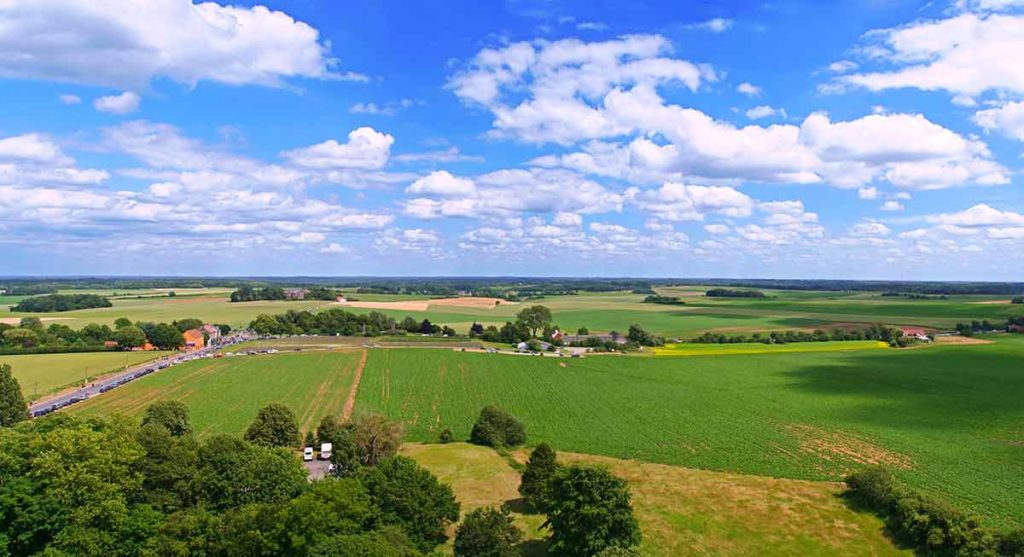
Belgium is home to many historical landmarks linked with some of the bloodiest battles in history, but none more famous than the Waterloo Battlefield.
Marked by The Lions Mound atop the hill, the Waterloo Battlefield commemorates the location where on 18th June 1815, 250,000 men from more than seven nations saw battle.
It was the most significant and bloodiest battle of the time.
The battlefield has attracted folks since 19th June 1815, as upper-class residents of the area wanted to see the ferocity of the outcome of the battle.
The battlefield today is pleasant to walk around, however, the biggest draw is the Lions Mount and adjacent panoramic painting of the battle.
A small visitor centre on-site provides further information and videos for curious tourists.
Waterloo Battlefield is at Route du Lion, 1420 Braine-l’Alleud.
18- Tyne Cot Cemetery
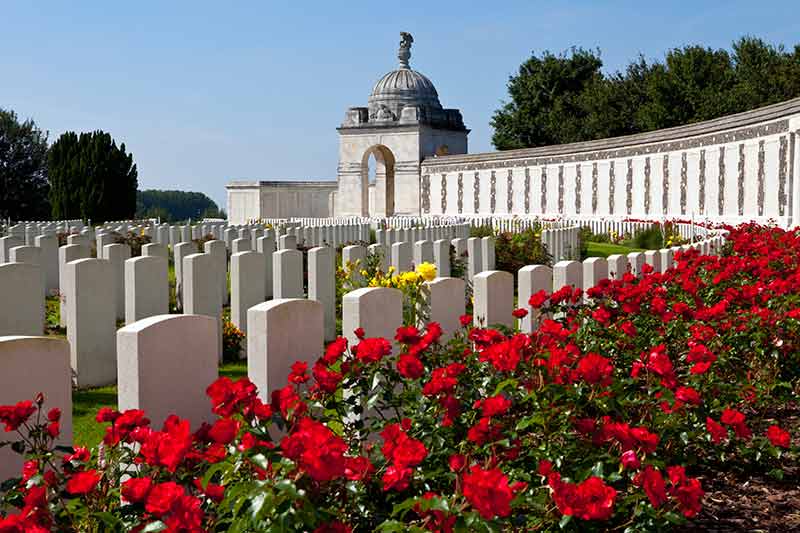
Tyne Cot was named by the Northumberland Fusiliers, who called a barn at a crossing on the Passchendaele-Broodseinde Road Tyne Cottage.
Sir Herbert Baker designed the cemetery, which is the largest cemetery of Commonwealth servicemen, with 11,961 buried or commemorated at the site.
Within the cemetery is Tyne Cot Memorial, which commemorates 35,000 servicemen from the United Kingdom and New Zealand whose final resting places are unknown.
Tyne Cot Cemetery is at Vijfwegestraat, 8980 Zonnebeke.
19- Gravensteen Castle
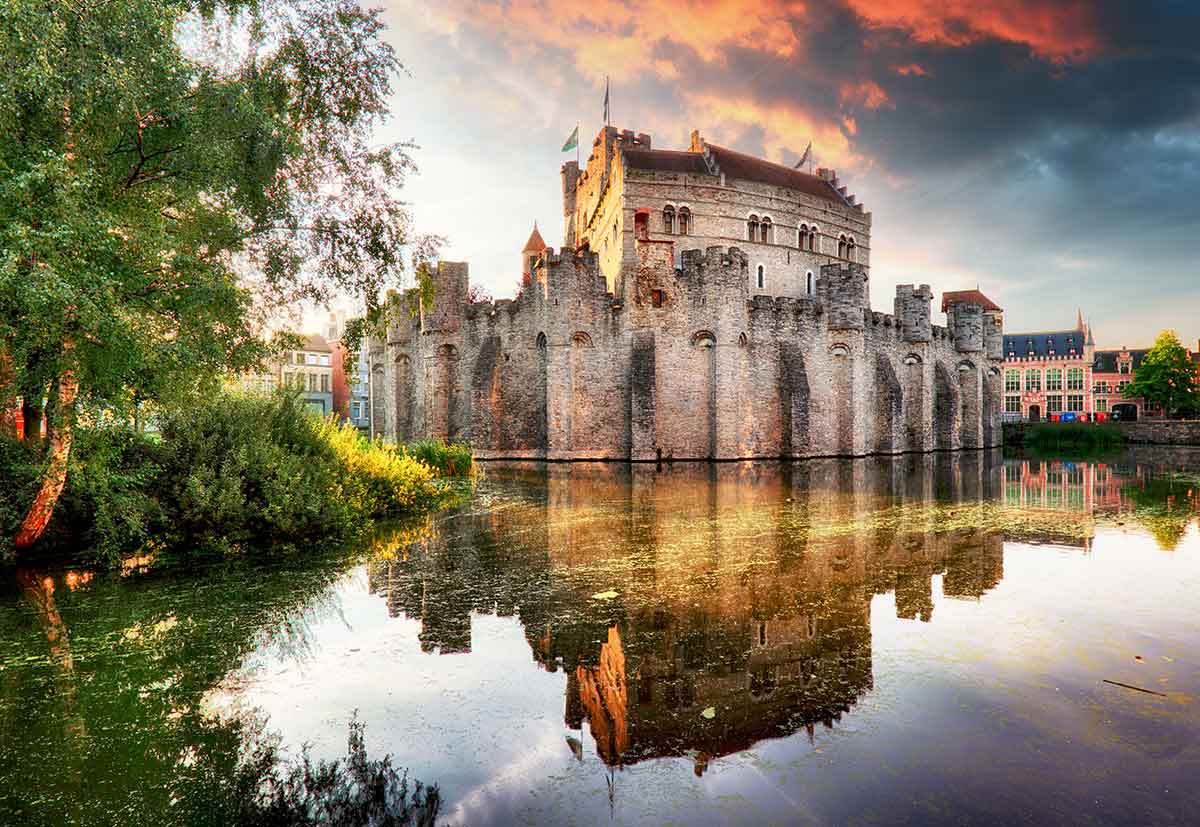
Gravensteen Castle or the ‘Castle of the Counts’ is a significant historical landmark in Ghent.
The castle has a turbulent history and is open for visitors to explore.
Count Philip of Alsace built the castle in 1180 from stone over pre-existing wooden constructions.
Following its life as a home for Counts, the castle became a factory complex in 1807, housing a cotton mill and homes for the workers in outbuildings.
Following the closure of the mill, the castle was abandoned and left in a state of disrepair.
Within the castle is a unique collection of torture equipment housed in an executioner’s cabinet used during inquisitions.
Gravensteen Castle is at Sint-Veerleplein 11, 9000, Ghent.
20- Dinant Citadel
Dinant Citadel dates back to the 9th century but the current citadel was built in 1815.
The citadel sits atop Dinant Rock and is accessible by a cable car from the town centre, or by climbing the 408 steps to the top.
From the castle, the views across the Meuse Valley are spectacular.
The citadel is now a museum of weapons and history.
Within the museum are displays of the ‘Sacking of Dinant’ by Charles the Bold in 1466 and the massacre of 674 civilians in 1914.
Dinant Citadel is at Place Reine Astrid 5, 5500 Dinant.
More Landmarks in Asia:
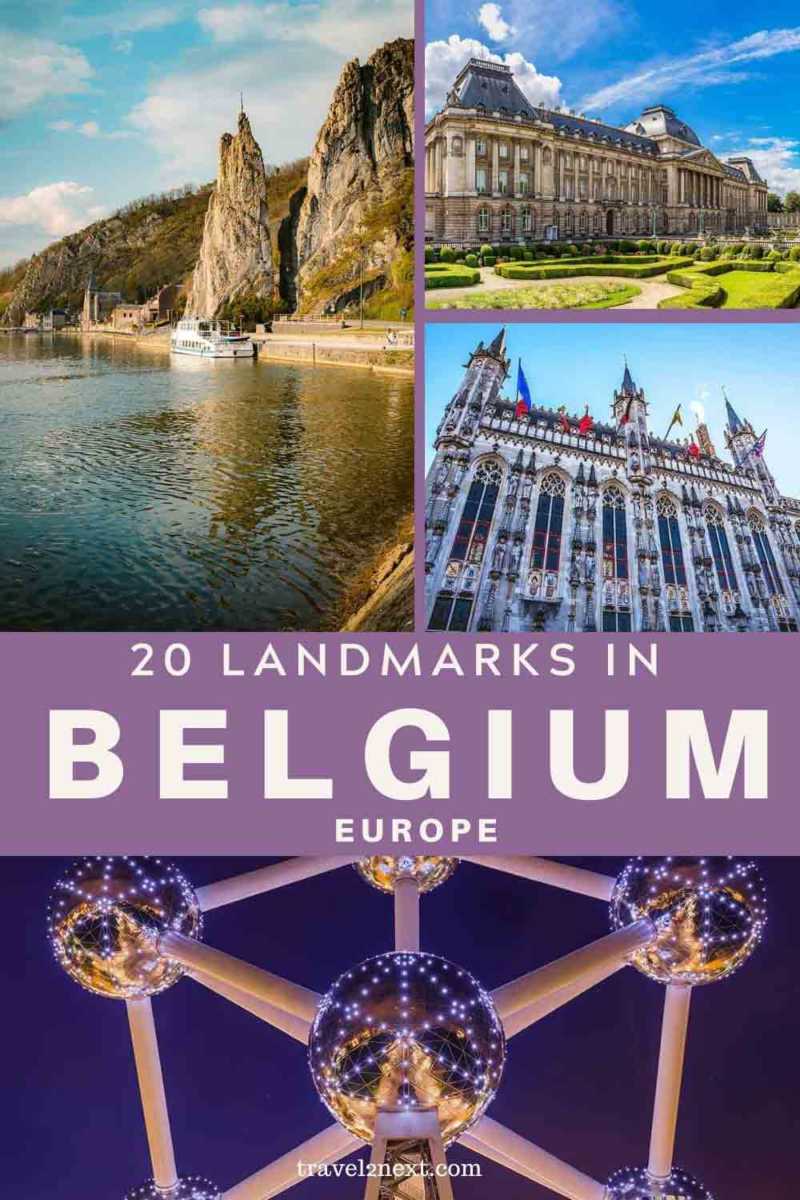
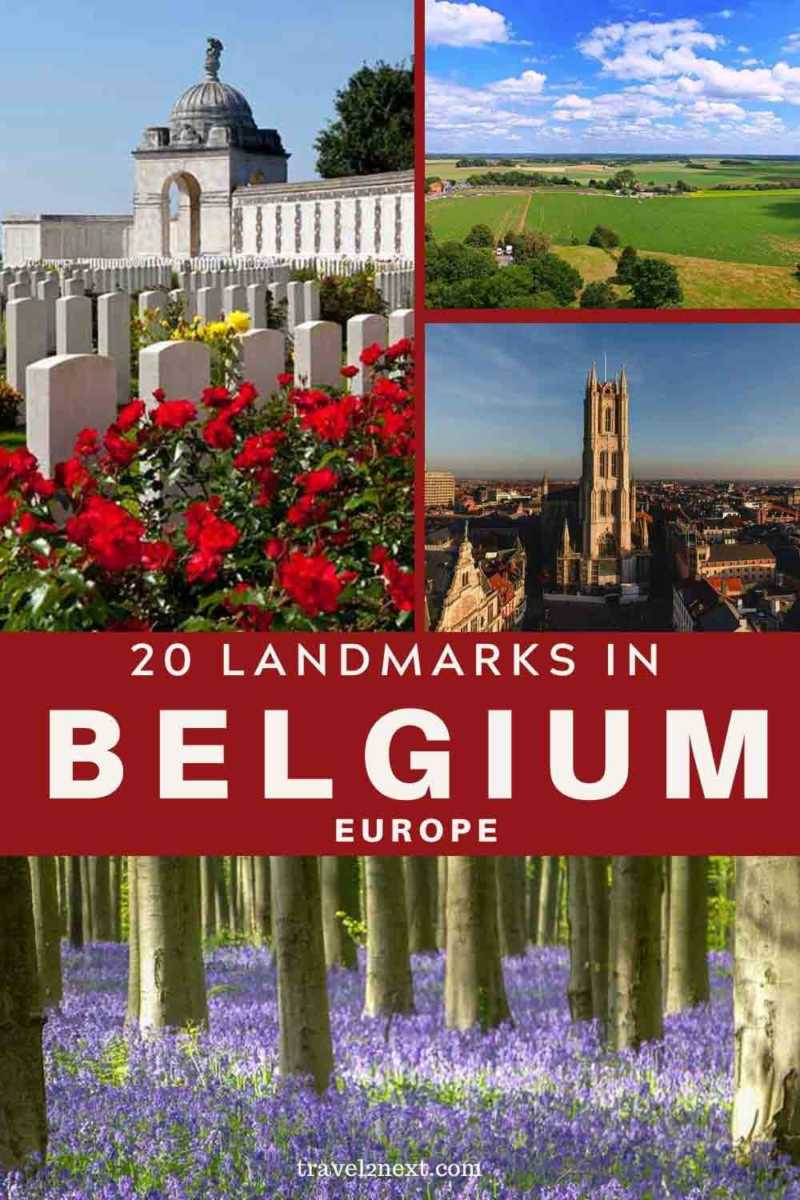
Plan Your Trip

Rent A Car – Find the best car rental rates at Discover Cars. They compare car hire companies to provide you with the best deal right now.

Find A Hotel – If you’re curious about this article and are looking for somewhere to stay, take a look at these amazing hotels.
